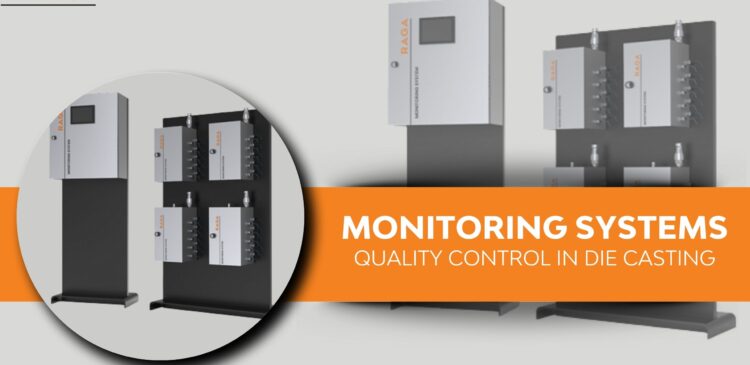Quality Control in Die Casting – Die Casting Monitoring Systems

In high-precision manufacturing, quality control in die casting is a critical factor for success. With increasing demand for fine finished components and lean production methods, manufacturers are turning to Die Casting Monitoring Systems to ensure excellence at every stage of production.
This blog highlights the crucial role of Die Casting Monitoring Systems in enhancing quality, efficiency, and sustainability in precision manufacturing. It explains how real-time monitoring detects defects like porosity and shrinkage early, reducing scrap and improving casting consistency. It explores key components such as temperature sensors, AI-powered analytics, and cloud-based monitoring, all of which help optimize cycle times and prevent costly rejections. It also addresses common challenges like integration costs and maintenance. Finally, it showcases how Raga Group is leading innovation with smart sensors, automated feedback loops, and predictive technology, driving the future of die casting with smarter, more sustainable processes.
Why Monitoring Systems Are Crucial for Die Casting
Die casting is a complex process that demands precision. Even minor defects can lead to major performance issues or product recalls. Here’s why implementing Die Casting Monitoring Systems is no longer optional:
– Real-time defect detection
– Improved cycle efficiency
– Reduced scrap and material waste
– Better compliance with industry standards
By using advanced sensors, predictive analytics, and automated adjustments, manufacturers can achieve consistent output and reduce costs.
The Role of Monitoring Systems in Die Casting Quality Control
1. Detecting Defects in Real-Time
Monitoring systems use high-precision sensors to identify casting issues such as:
– Air entrapment
– Shrinkage
– Porosity
These problems are caught during the casting process—not after. Real-time feedback allows quick adjustments to parameters, preventing defective parts from progressing down the line.
2. Process Optimization & Cycle Efficiency
By continuously tracking metrics like metal flow and mould cooling rates, monitoring systems can:
– Reduce cycle time
– Automate adjustments for maximum output
– Ensure consistent quality
3. Reducing Scrap & Material Waste
Detecting issues early avoids the cost of scrapping entire batches. Monitoring systems:
– Spot defects before production is completed.
– Reduce unnecessary material use.
– Contribute to sustainable manufacturing practices.
Key Components of Die Casting Monitoring Systems
Modern Die Casting Monitoring Systems combine several technologies to create an integrated quality control ecosystem:
– Temperature Sensors & Thermal Mapping – Ensure optimal mould conditions.
– Pressure Monitoring – Prevent incomplete mould filling and air pockets.
– Automated Cameras – Catch surface-level flaws in real time.
– AI-Powered Predictive Analytics – Forecast issues and adapt operations on the go.
These components provide total process visibility and control, minimizing manual errors.
Advanced Technologies Transforming Die Casting
A. AI & Machine Learning for Quality Prediction
AI-driven monitoring tools can analyze large volumes of production data to:
– Predict casting defects before they occur
– Recommend proactive corrections
– Enhance precision and consistency
B. IoT & Cloud-Based Monitoring
With the help of IoT sensors and cloud integration, manufacturers gain:
– Live tracking of casting parameters
– Remote access to performance data
– Centralized monitoring for multiple locations
C. Automated Feedback Loops
Automated systems can adjust die casting parameters—like mould pressure or cooling rate—without human intervention. This reduces downtime, maintains accuracy, and ensures peak operational efficiency.
Benefits of Implementing Die Casting Monitoring Systems
When you invest in Die Casting Monitoring Systems, you unlock:
– Consistent, high-quality production
– Lower operational costs & waste
– Real-time process optimization
– Better industry compliance & audits
– Fewer defects and rejections
Common Challenges in Adoption
Despite the benefits, some manufacturers hesitate due to:
– High upfront investment
– Integration issues with older equipment
– Ongoing maintenance and calibration needs
But long-term savings and quality improvements often outweigh the initial costs.
Raga Group’s Innovations in Die Casting Monitoring
We stand out by delivering next-gen monitoring solutions tailored to modern die casting needs. Our innovations include:
– Smart sensors & real-time data dashboards
– AI-backed quality prediction
– Automated feedback systems that adjust parameters on the fly
Whether you’re upgrading legacy equipment or designing a new line, we offer customized solutions that elevate your production efficiency and quality.
Future Trends in Die Casting Monitoring Systems
Looking ahead, we anticipate:
AI-automated defect detection across entire batches
Predictive maintenance powered by machine learning
Sustainable monitoring solutions that minimize energy and resource use
The future of die casting is smarter, cleaner, and more reliable.
Conclusion
In today’s competitive landscape, Die Casting Monitoring Systems aren’t just a technological upgrade—they’re a necessity. They help manufacturers deliver consistent, high-quality castings while reducing waste and improving efficiency.
Partnering with pioneers like Raga Group ensures your systems are not only advanced but also future-ready.
FAQs
Q1: How do monitoring systems reduce defects in die casting?
A1: By using real-time tracking to identify issues like porosity and shrinkage, enabling immediate corrections.
Q2: What are the biggest benefits of AI-powered monitoring?
A2: Predicts quality issues before they happen, leading to lower defect rates and higher productivity.
Q3: Can older die-casting machines be upgraded?
A3: Yes. Retrofit solutions enable legacy equipment to work with modern monitoring tech.
Q4: How does Raga Group improve casting performance?
A4: Through smart sensors, AI-driven feedback loops, and precise data analytics for quality assurance.
Q5: Is it worth investing in die casting monitoring systems?
A5: Absolutely. The long-term benefits—fewer defects, reduced waste, and better output—far outweigh the initial investment.
